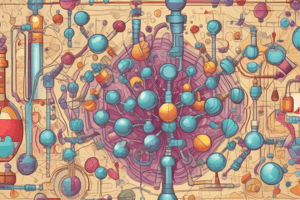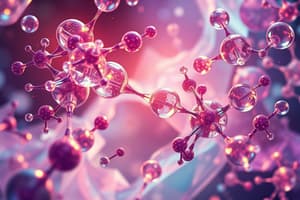Podcast
Questions and Answers
What is the total number of credit hours for the first two weeks of the course?
What is the total number of credit hours for the first two weeks of the course?
- 4 hours (correct)
- 8 hours
- 6 hours
- 2 hours
How many topics are covered in the β-Lactam antibiotics segment?
How many topics are covered in the β-Lactam antibiotics segment?
- 2 topics (correct)
- 3 topics
- 4 topics
- 1 topic
Which of the following drug classes is being introduced during week 5?
Which of the following drug classes is being introduced during week 5?
- Macrolides
- Tetracyclines
- Cephalosporins (correct)
- Aminoglycosides
Which activity is scheduled during week 10?
Which activity is scheduled during week 10?
What is one of the new components introduced during the introduction of antiviral agents?
What is one of the new components introduced during the introduction of antiviral agents?
What is the primary focus of pharmaceutical care according to the provided information?
What is the primary focus of pharmaceutical care according to the provided information?
Which ability is emphasized for professionals in personal practice?
Which ability is emphasized for professionals in personal practice?
What should effective communication in medicinal chemistry include?
What should effective communication in medicinal chemistry include?
What kind of technologies should be utilized in healthcare services according to the information?
What kind of technologies should be utilized in healthcare services according to the information?
What aspect of professional development is highlighted in the content?
What aspect of professional development is highlighted in the content?
Which of the following best describes the primary objective of medicinal chemistry?
Which of the following best describes the primary objective of medicinal chemistry?
What is one of the key outcomes for students completing the Medicinal Chemistry-I course?
What is one of the key outcomes for students completing the Medicinal Chemistry-I course?
Which principle is applied to evaluate the activity of chemotherapeutic agents?
Which principle is applied to evaluate the activity of chemotherapeutic agents?
What is an essential ethical practice in the field of medicinal chemistry?
What is an essential ethical practice in the field of medicinal chemistry?
Which method is included in the course principles for designing new molecular entities?
Which method is included in the course principles for designing new molecular entities?
What type of knowledge should students develop related to drug production in medicinal chemistry?
What type of knowledge should students develop related to drug production in medicinal chemistry?
In the context of drug development principles, which approach is encouraged?
In the context of drug development principles, which approach is encouraged?
What is the relationship that students should recognize regarding chemotherapeutic drugs?
What is the relationship that students should recognize regarding chemotherapeutic drugs?
What is the primary focus of medicinal chemistry?
What is the primary focus of medicinal chemistry?
Which method is used to assess students' understanding in the 4th and 10th weeks?
Which method is used to assess students' understanding in the 4th and 10th weeks?
What percentage of the final grade does the Written Exam contribute?
What percentage of the final grade does the Written Exam contribute?
Which of the following is NOT evaluated by the midterm exam?
Which of the following is NOT evaluated by the midterm exam?
Which element is part of the pharmacokinetics process as related to medicinal chemistry?
Which element is part of the pharmacokinetics process as related to medicinal chemistry?
What is assessed during class activities such as discussions or presentations?
What is assessed during class activities such as discussions or presentations?
What does ADME stand for in pharmacokinetics?
What does ADME stand for in pharmacokinetics?
Which activity is part of the course schedule to assess student understanding?
Which activity is part of the course schedule to assess student understanding?
Which statement correctly describes acidic functional groups in drugs?
Which statement correctly describes acidic functional groups in drugs?
What defines a basic drug according to the Bronsted-Lowery theory?
What defines a basic drug according to the Bronsted-Lowery theory?
Which part of the drug structure is primarily hydrophilic?
Which part of the drug structure is primarily hydrophilic?
Which of the following would decrease the acidity of benzoic acid?
Which of the following would decrease the acidity of benzoic acid?
Which phase in pharmacokinetics involves the interaction of the drug with its site of action?
Which phase in pharmacokinetics involves the interaction of the drug with its site of action?
What effect do electron withdrawing groups have on drug compounds?
What effect do electron withdrawing groups have on drug compounds?
Which of the following is NOT a component of the pharmacokinetic phase?
Which of the following is NOT a component of the pharmacokinetic phase?
Halogen atoms such as F, Cl, Br, or I are characterized by which of the following properties?
Halogen atoms such as F, Cl, Br, or I are characterized by which of the following properties?
What is the First Pass Effect in drug metabolism?
What is the First Pass Effect in drug metabolism?
Which phase involves the interaction of a drug with its receptor?
Which phase involves the interaction of a drug with its receptor?
What is the pharmacophore of a drug?
What is the pharmacophore of a drug?
What does the Structure-Activity Relationship (SAR) indicate?
What does the Structure-Activity Relationship (SAR) indicate?
Which property is considered crucial in determining drug activity?
Which property is considered crucial in determining drug activity?
Intrinsic activity in pharmacology refers to what?
Intrinsic activity in pharmacology refers to what?
Which of the following best describes affinity?
Which of the following best describes affinity?
Flashcards
Medicinal Chemistry
Medicinal Chemistry
The study of how chemical structures of drugs relate to their biological activities. It's about understanding how drugs work at the molecular level and how we can design better drugs.
Chemotherapeutic Agents
Chemotherapeutic Agents
Drugs designed to treat cancer by targeting specific pathways involved in cancer cell growth and survival.
Structure Activity Relationship (SAR)
Structure Activity Relationship (SAR)
The study of the relationship between the chemical structure of a compound and its biological activity. It's used to predict how changes in a drug's structure will affect its function.
Bioinformatics and Computer-Aided Tools
Bioinformatics and Computer-Aided Tools
Signup and view all the flashcards
Drug Design
Drug Design
Signup and view all the flashcards
Side Effects and Toxicity
Side Effects and Toxicity
Signup and view all the flashcards
Drug Development
Drug Development
Signup and view all the flashcards
Mode of Action
Mode of Action
Signup and view all the flashcards
Pharmacodynamics
Pharmacodynamics
Signup and view all the flashcards
Drug Chemistry
Drug Chemistry
Signup and view all the flashcards
Systematic Approaches
Systematic Approaches
Signup and view all the flashcards
Scientific Communication
Scientific Communication
Signup and view all the flashcards
Ongoing Professional Development
Ongoing Professional Development
Signup and view all the flashcards
Beta- Lactam Antibiotics
Beta- Lactam Antibiotics
Signup and view all the flashcards
Drug Action
Drug Action
Signup and view all the flashcards
Antibacterial agents
Antibacterial agents
Signup and view all the flashcards
Anti-fungal agents
Anti-fungal agents
Signup and view all the flashcards
Pharmacokinetics (ADME)
Pharmacokinetics (ADME)
Signup and view all the flashcards
Drug Discovery and Development
Drug Discovery and Development
Signup and view all the flashcards
PowerPoint Presentations (PPT)
PowerPoint Presentations (PPT)
Signup and view all the flashcards
Formative Assessment
Formative Assessment
Signup and view all the flashcards
Class Activity/Discussion/Brainstorming
Class Activity/Discussion/Brainstorming
Signup and view all the flashcards
Midterm Exam (MCQ)
Midterm Exam (MCQ)
Signup and view all the flashcards
Pharmacokinetic Phase (ADME)
Pharmacokinetic Phase (ADME)
Signup and view all the flashcards
First Pass Effect
First Pass Effect
Signup and view all the flashcards
Pharmacodynamic Phase
Pharmacodynamic Phase
Signup and view all the flashcards
Pharmacophore
Pharmacophore
Signup and view all the flashcards
Affinity
Affinity
Signup and view all the flashcards
Intrinsic Activity (Efficacy)
Intrinsic Activity (Efficacy)
Signup and view all the flashcards
Hydrophilic/Lipophilic Properties (Solubility)
Hydrophilic/Lipophilic Properties (Solubility)
Signup and view all the flashcards
Acidic drug
Acidic drug
Signup and view all the flashcards
Basic drug
Basic drug
Signup and view all the flashcards
Hydrophilic
Hydrophilic
Signup and view all the flashcards
Lipophilic
Lipophilic
Signup and view all the flashcards
Drug Absorption
Drug Absorption
Signup and view all the flashcards
Drug Distribution
Drug Distribution
Signup and view all the flashcards
Drug Metabolism
Drug Metabolism
Signup and view all the flashcards
Study Notes
Course Information
- Course Title: Medicinal Chemistry-I
- Course Code: PMC-306
- Program: Pharm D Program
- Lecturer: Dr. Amal El-Masry
- Department: Medicinal Chemistry Department
- Office Hours: Monday (9.0 AM – 3.0 PM)
- Course Description: According to the By-law
Aims & Objectives
- Identify the principles of medicinal chemistry
- Recognize the relationships between the chemical structures of different chemotherapeutic drugs and biological activities
- Understand the different modes of action of different classes of anticancer agents
Course Learning Outcomes (Domain 1 - Fundamental Knowledge)
- Recognize in-depth knowledge of medicinal chemistry as one of the applied pharmaceutical sciences
- Manipulate knowledge to provide information about drug production and proper use
- Discuss the mode of action and therapeutic uses of chemotherapeutic agents and anticancer drugs
Course Learning Outcomes (Domain 2 - Professional and Ethical Practice)
- Adapt medicinal chemistry principles to systemic drug development approaches
- Apply structural activity relationships to evaluate the activity of chemotherapeutic agents based on structural similarities
- Apply bioinformatics and modeling programs in designing new molecular entities
- Detect possible side effects and toxicity of drug molecules based on structural features
- Utilize scientific principles for research and evidence-based approaches
Course Learning Outcomes (Domain 3 - Pharmaceutical Care)
- Counsel patients on proper antibiotic use based on drug chemistry, pharmacodynamics and possible side effects
Course Learning Outcomes (Domain 4 - Personal Practice)
- Gather and analyze data independently and collaboratively with drug chemistry experts
- Participate in healthcare service delivery and contribute to pharmacy knowledge
- Communicate effectively using scientific language in the field of medicinal chemistry
- Employ technology to deliver information effectively
- Utilize ongoing professional development concepts
Course Content
- Introductory lecture - Physico-chemical properties of drug action
- Beta-lactam antibiotics (Penicillins)
- Beta-lactam antibiotics (Cephalosporins)
- Macrolides + Tetracyclines
- Sulfonamides + Dihydrofolate reductase inhibitors
- Aminoglycosides
- Other Agents (Chloramphenicol, Antimycobacterial Agents, Antileprotics, Antiseptic agents, Anti-fungal agents)
- Antiviral drugs
- Antineoplastic drugs
Teaching and Learning Methods
- Computer-aided learning (online learning, interactive discussions, presentations)
- Self-learning (quizzes)
- Class activities (discussion, brainstorming)
- Case studies, posters, presentations
Student Assessment
- Midterm Exam (MCQs): 20% (8th week)
- Written Exam (MCQs): 50% (16th, 17th week)
- Semester work (Activity 1 and 2): 30% (4th, 10th week)
Important Definitions
- Pharmacophore: A structural unit in a drug essential for receptor interaction
- Structure-Activity Relationship (SAR): The relationship between the chemical structure of a drug and its biological activity
- Affinity: The ability of a drug to interact with a receptor
- Intrinsic Activity (Efficacy): The ability of a drug-receptor complex to produce a biological effect
Physicochemical Properties of Drugs
- Acid/base properties
- Hydrophilic/lipophilic properties (water and lipid solubility)
- Electronic effect of substituents
- Steric effect of substituents
Studying That Suits You
Use AI to generate personalized quizzes and flashcards to suit your learning preferences.




